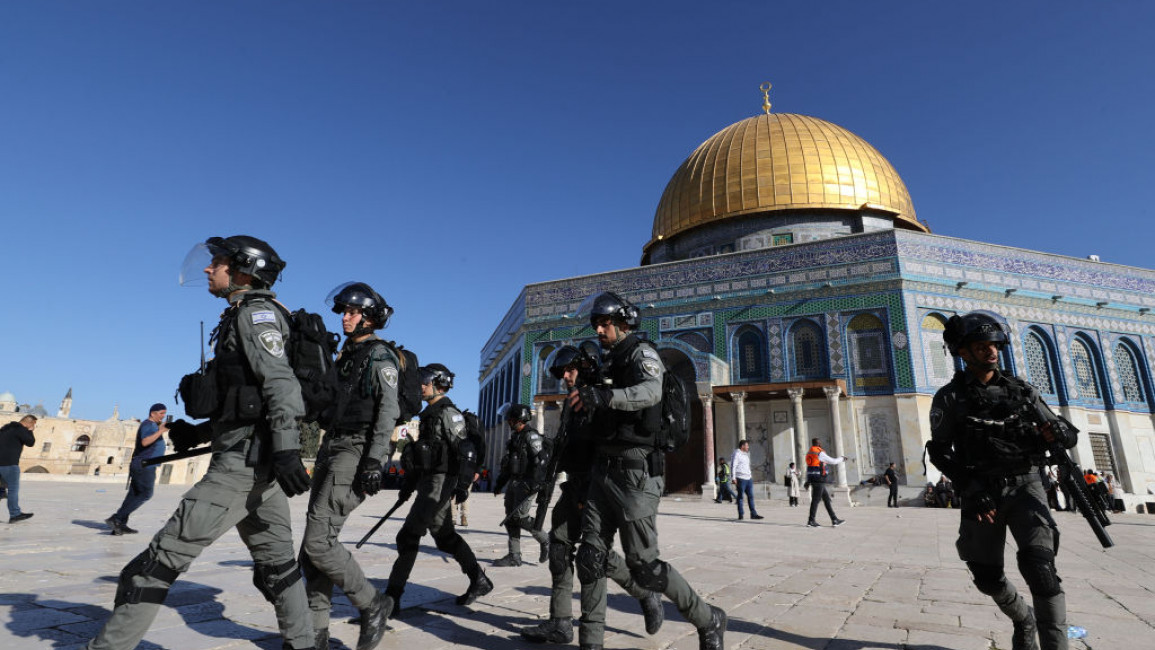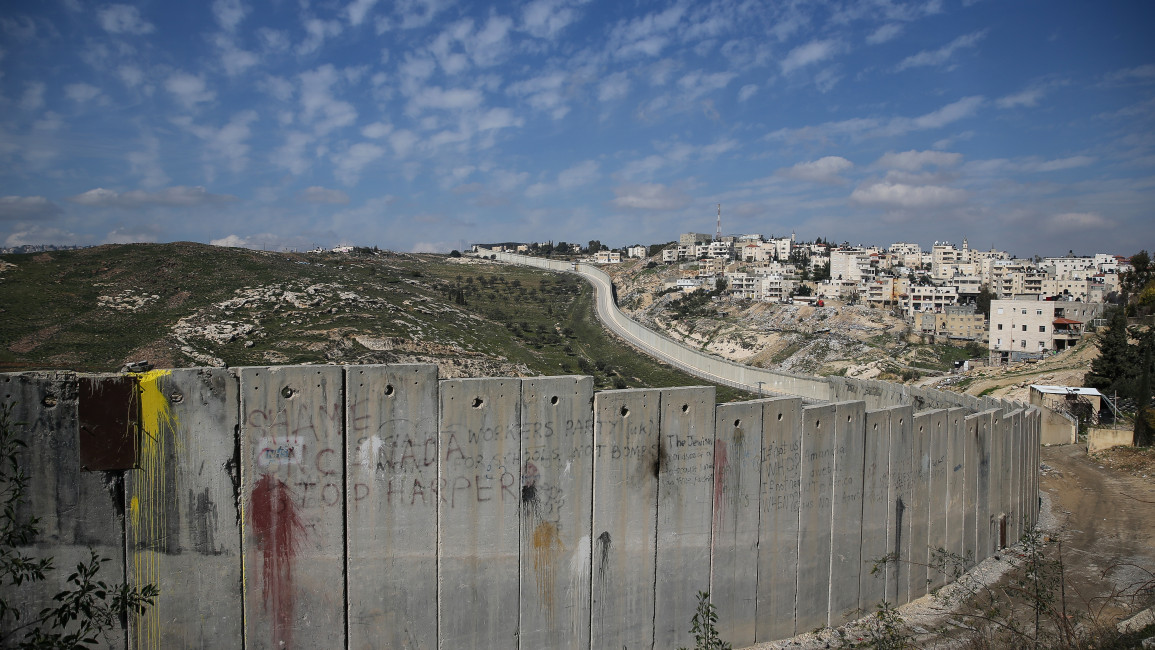
How Israel is de-Palestinising Jerusalem

On the first day of Ramadan, ostensibly to maintain calm, Israel intensified its security measures in occupied East Jerusalem.
Various police units, including Israel’s counter-terrorism force, Yamam, were deployed around the Old City. Barriers were erected and Palestinian access to the Al-Aqsa Mosque compound was restricted. Large numbers of Israeli extremists were simultaneously allowed to visit the religious site.
And like last year, when events ultimately escalated into a war in Gaza, the Israeli measures prompted Palestinian protests, followed by an aggressive assault by Israeli security forces on worshippers inside and around the Al-Aqsa Mosque compound. Dozens were injured and arrested.
This also led to confrontations with the Israeli army across the occupied West Bank and some Palestinian towns in Israel. Gaza’s armed groups went on high alert, warning that changing the status quo at Al-Aqsa is a red line.
Succumbing to international pressure and fearing the collapse of his coalition, Israeli PM Naftali Bennett temporarily barred the increasingly emboldened Israeli hardliners from the site, but only until the end of Ramadan.
Palestinians fear that Israel is attempting to change the status quo in East Jerusalem and the temporary ban on visits will soon give way to another round of escalation – a reality that highlights the political intractability of Jerusalem throughout its long history.
"Palestinians fear that Israel is attempting to change the status quo in East Jerusalem"
The spiritual heartland of the three Abrahamic faiths, today’s conflict over the city, at least from a Palestinian Muslim and Christian perspective, is less a feud over ancient religious rights and more a question of injustice defined through a modern settler-colonial framework.
British troops captured Jerusalem from the Ottoman Empire in 1917, and in 1922 the League of Nations formally awarded Britain a Mandate over Palestine. Under British rule, Palestine returned to being a distinct political and administrative entity, and the status quo of Jerusalem as a city for Arab Muslims, Christians, and Jews remained somewhat unchanged.
But Britain issued the Balfour Declaration in 1917, which promised the Zionist movement a Jewish homeland in Palestine. That, among other things, facilitated the influx of European Jews into Palestine, which affected Jerusalem’s demographic structure.
|
|
As violence escalated between the Palestinian and Jewish communities, including attacks by Zionist militias on British forces, Britain handed over responsibility to the UN, who in 1947 issued a resolution to partition Palestine into an Arab state (43.53% of Mandatory Palestine) and a Jewish state (56.47%).
Jerusalem was assigned as a corpus separatum status (separate entity) governed by a special international body.
Zionist militias soon launched a campaign of ethnic cleansing against Palestinians, expanding the UN-designated borders of the Jewish state to include more than 78 percent of historic Palestine, including West Jerusalem. East Jerusalem fell under Jordanian control, along with the West Bank.
'De-Palestinisation'
Israel occupied East Jerusalem in 1967 following the Arab-Israeli war and unilaterally annexed it in 1980, ushering in a new and more aggressive phase to de-Palestinise the city. Since then, and especially in the late 1990s, Jerusalem has progressively become paramount to the conflict and, as Palestinian writer Tareq Baconi argues, “a microcosm of Palestinian dispossession”.
Palestinians today represent 38% of East Jerusalem’s population at just over 420,000 people, exceeding the 30% threshold set by the occupation authorities in the 1970s to maintain a Jewish majority.
Due in part to a higher birth rate, the 'demographic cap’ seems to have failed. To compensate, a set of discriminatory measures have been incrementally introduced to ‘Judaise’ the city.
Palestinian scholar at Al-Quds University Walid Salim says that Israel’s control of Jerusalem has been achieved using a set of intertwined procedures. The most common is dispossession, which includes home/land confiscations, demolitions, discriminatory taxation, and nearly impossible-to-obtain home repair/expansion permits.
"Having progressively lost control of their religious sites and national symbols, many Palestinians view Jerusalem, and the Al-Aqsa Mosque compound in particular, as their last stand"
Another is legal discrimination. Palestinian Jerusalemites are categorised as ‘permanent residents’ and are neither citizens of Israel nor the Palestinian Authority, thus vulnerable to residency revocation.
Since 1967, the Israeli state has revoked the residency permits of over 14,000 Palestinians - 11,500 since 1995 alone. The grounds for revocation were broadened to include Palestinians who resided continuously for three years outside of East Jerusalem.
The third measure is geographical isolation. Palestinian Jerusalemites have been physically separated from the Palestinian collective in the West Bank and Gaza. Checkpoints and settlements continuously built in the spaces between East Jerusalem and the rest of the occupied territories are making the separation irrevocable.
Upsetting the status quo
In the early years of the occupation Israel was relatively at ease with East Jerusalem’s status quo, whereby the entry of Jews into the Al-Aqsa Mosque compound, known as the Temple Mount to Jews, was under Jordanian control and non-Muslim prayer was banned at the site. This position was partly due to the illegality under international law, and political complexities, of Israel’s military occupation.
Furthermore, soon after 1967, Israel's Ashkenazi and Sephardi chief rabbis issued a Halachic decree forbidding the entry of Jews into the Al-Aqsa compound on the grounds it was deemed a violation of Jewish religious law.
Progressively, however, and with the rise of Israel’s right, the concept of legality was overtaken by a self-perceived notion of legitimacy regarding the occupied territories, and especially Jerusalem.
It became more common to label the occupied Palestinian territories as ‘disputed’, therefore removing a clear-cut definition of the occupation, and describing Jerusalem as a ‘unified city’ and Israel’s ‘eternal capital’.
This trend, Palestinian academic Joseph Massad explains, became particularly visible after the Oslo Accords for fear that Palestinians might be granted authority over the Al-Aqsa Mosque compound, and especially after the Israel-Jordan Peace Accords in 1994, in which Israel was to respect Jordan's “special role... in the Muslim Holy shrines in Jerusalem”.
Increasingly influential in Israel’s decision-making circles, mainstream religious Zionists, of which PM Naftali Bennett is one, are now encouraging - or at least approving of – incursions into the Al-Aqsa compound by Israeli hardliners, most of whom actively promote plans to establish Israeli control over the holy site.
The phenomenon has grown so mainstream that many secular Zionists now believe that Israel's sovereignty and freedom of worship for Jews at the religious cannot be abridged.
|
|
Former US president Donald Trump’s recognition of Jerusalem as Israel’s capital provided the Jewish state with political cover to further reshape the status quo and strengthen Israeli attachment to the city.
However, Israeli attempts to upset the status quo have repeatedly proven to be the quickest route to regional conflagrations.
In 1989, a Jewish fundamentalist group named the Temple Mount Faithful tried to lay a cornerstone for building the ‘Third Temple’ inside the Al-Aqsa Mosque compound. The ensuing protests saw the death of twenty Palestinians at the hands of Israeli police. Several attempts to lay the stone in the following years were unsuccessful.
In 1996, widespread protests erupted following Israel’s opening of a tunnel under the Al-Aqsa Mosque compound. The Israeli army and police killed 100 Palestinian protesters and injured over a thousand others.
If any event bears witness to Jerusalem’s volatility, it is Ariel Sharon’s visit to the Al-Aqsa Mosque compound surrounded by hundreds of Israeli security personnel in 2000. It ignited the Second Intifada, caused the death of thousands of Palestinians and hundreds of Israelis, and irreparably destroyed the peace process.
Sharon’s visit arguably cleared the way for more daring steps to increase the incursion of Israeli extremists into Al-Aqsa, and over the following years restrictions on Palestinian access led to several upsurges in tensions, which have grown more explosive and violent in the past two years.
Before 2003, the Israeli government allowed a maximum of three religious Jews to visit the site at the same time. The number of overall visits have surged since then, reaching over a thousand in the three months preceding the current tensions, a 35% increase compared to previous years.
"None of the ongoing efforts to deescalate come anywhere close to tackling the core problem, leaving the door wide open for continued Israeli violations in East Jerusalem and, consequently, larger escalations"
Jewish extremists have even disguised themselves as Muslim worshippers to infiltrate the holy site.
For Palestinians, the trajectory is abundantly clear: a gradual take-over of Al-Aqsa. Many fear a re-enactment, albeit at a larger and more dramatic level, of what happened at the Ibrahimi Mosque in Hebron.
Since the 1994 Hebron massacre, when a US-born Jewish settler shot dead 29 Palestinians, Israel has gradually heightened its control of the Ibrahimi Mosque, known as the Cave of the Patriarchs to Jews. The mosque’s historical characteristics have been incrementally altered and Palestinian access to it severely restricted.
Having progressively lost control of their religious sites and national symbols to the Israeli occupation, many Palestinians view Jerusalem, and the Al-Aqsa Mosque compound in particular, as their last stand.
Not only for existential reasons related to their national and religious identity and the prospect of a future state with East Jerusalem as its capital, but also due to the possibly devastating effect of an Israeli takeover of Islam’s third holiest site on the broader Arab and Muslim context.
Thus far, Jordan, on Israel’s request, has successfully pressured the Palestinian Authority to prevent the situation in Jerusalem from turning into a full-scale Intifada across the West Bank. Egypt has also pressured Hamas in Gaza not to engage militarily with Israel.
Yet, none of the ongoing efforts to deescalate come anywhere close to tackling the core problem, leaving the door wide open for continued Israeli violations in East Jerusalem and, consequently, larger escalations.
Dr Emad Moussa is a researcher and writer who specialises in the politics and political psychology of Palestine/Israel.
Follow him on Twitter: @emadmoussa




